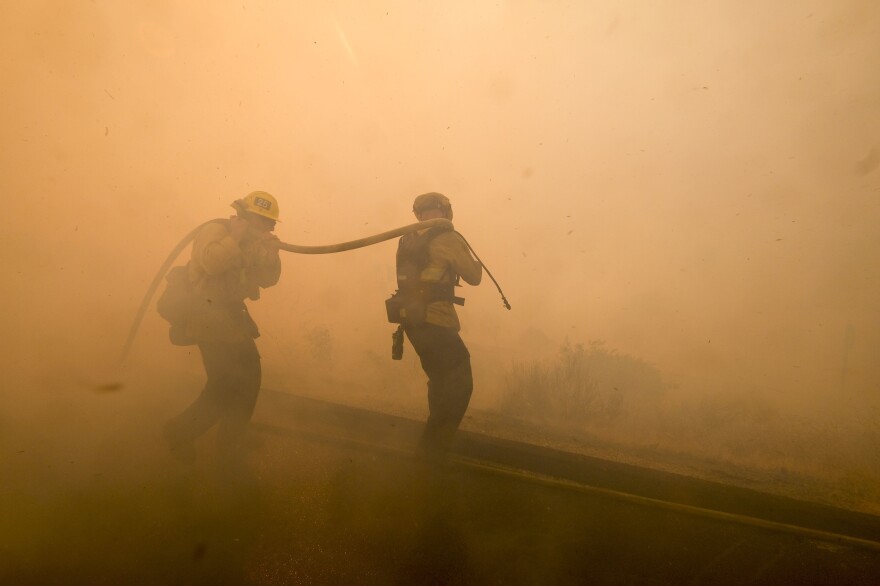Updated at 10:48 p.m. ET
Wildfires continued to tear through Northern and Southern California on Monday, where firefighters were at the mercy of dry air and whipping winds fanning the deadly blazes. At least 44 people have died statewide; many people remain unaccounted for.
In a year of record-breaking fires, Cal Fire Chief Ken Pimlott told NPR's All Things Considered the Camp fire in the north and Woolsey fire in the south may be "the most destructive and the deadliest" on record for the state.
In Northern California, the Camp Fire, which ripped through the town of Paradise, 90 miles north of Sacramento, has killed 42 people, authorities said.
Butte County Sheriff Kory Honea indicated that more human remains from that fire could be found. He said that the county will receive two portable morgue units and cadaver dogs.
He said his department had received more than 1,500 calls from friends and relatives trying to locate people in the area. He said investigators had determined that 231 of those people were safe but since an unknown number of the calls were duplicates, he couldn't tell how many people remain unaccounted for.
President Trump tweeted Monday night that he had signed a major disaster declaration for California.


As of Monday evening ET, the Camp fire remained 30 percent contained with 117,000 acres burned (more than 182 square miles).
"We certainly hope that the fatality count doesn't increase but we know there is a strong potential for that" as authorities continue to sift through ash, rubble and debris in search of missing persons, Pimlott said.
Authorities have yet to account for 228 people reported missing.

Slowing winds in the northern part of the state have given exhausted firefighters a sliver of a reprieve, according to Pimlott, who said the flames are "moving up onto some more rural areas " and through "what used to be Paradise."
However, he cautioned, "We still have very, very dry weather and don't see that changing at all within the next week. "

The Camp fire has destroyed more than 7,100 buildings, the vast majority of them residences. About 52,000 people have evacuated the area and 1,385 people are in shelters.
Meanwhile, Southern California winds continue to drive the Woolsey Fire that is slashing a path from Thousand Oaks to the wealthy coastal enclave of Malibu.
"We've got 60 to 70 mph off shore Santa Ana winds blowing for the next several days and those are just deadly," Pimlott told NPR.


Two people have been reported dead in connection with the fire.
As of Monday evening, the Woolsey Fire in Los Angeles and Ventura counties has burned more than 93,000 acres and is only 30 percent contained. The estimated number of structures destroyed rose up to 370.
About 170,000 people are under mandatory evacuation.
Strained resources were stretched even further Monday morning by another wildfire in the hills north of Los Angeles.

The Peak Fire burned off of the 118 Freeway and into the hills near Simi Valley. The flames temporarily forced the closure of the highway and residents in the Box Canyon and Lake Manor areas were ordered to evacuate.
The "fast moving brush fire" was stopped at 105 acres within a couple hours by Ventura and Los Angeles county firefighters.
The National Weather service has extended a "red flag warning" through 5 p.m. PT on Wednesday, meaning active critical weather conditions of strong gusty winds and dry conditions will present a challenge to firefighters and containment efforts.

The last rainfall in the area that amounted to even a half-inch came 211 days ago.
The Camp Fire ramped up quickly from Saturday into Sunday, CalFire Battalion Chief Josh Bischof said. Some areas were calmer, including Paradise and Magalia, where responders entered and were able to "mop up patrol around structures," he said. Aircraft also were able to enter the "problem area" of Santos Ranch to contain the fire.

"There is still very steep, very challenging area between Santos Ranch up into the bottom part of Magalia," Bischof said. "However, we are making progress."
Authorities are anticipating additional spot fires and are primed and ready to combat potential fires in the areas south of North Fork Feather River.
Evacuation orders are in effect for Berry Creek, Rush Creek, Mountain House and Bloomer Hill.
In Southern California, those who fled included the Fortier family.
"All three peaks were on fire, with the wind blowing the flame" says Johnny Fortier, describing the scene. "I said an 'Our Father,' tried to bless our homes, and realized it's time to go."
"We basically left with the clothes on our bodies, some pictures from the wall, some religious items," said Fortier, who fled along with his wife, Shandra, and their three children.
The couple returned to their home on Sunday to find what Fortier called "a war zone." Of the home they had lived in for more than 12 years, he added, "its entire contents — it's all gone."
Some mandatory evacuation orders in the region have lifted, including areas in Thousand Oaks, where authorities anticipate sporadic utility outages.
Thousand Oaks Mayor Andrew Fox says it's likely that some of the town's residents who were affected by last week's shootings also were forced to evacuate — and that memorial services for the victims were delayed because of the fire.
Discussing the afternoon after the shooting, Fox told NPR's David Greene, "We very quickly pivoted into an evacuation center for fire."
Fox added, "The logistics to managing a fire of this magnitude, it's like moving an army, so you have to have places for firefighters to sleep, to eat."
Paramount Ranch — the backdrop for many films and television shows, including Westworld — has also been destroyed.
As NPR reported Saturday, investigators in Malibu are looking into the deaths of two people after their bodies were found "severely burned" inside a vehicle.
NPR's Laura Roman contributed to this report.
Copyright 2021 NPR. To see more, visit https://www.npr.org. 9(MDA5NTM4MTIyMDE0MTg3NDc2MTVlZjdmNQ001))




















